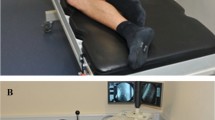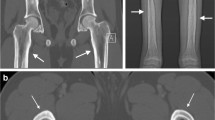Summary
This study examined the correlation between osteoporosis and the degeneration of intervertebral discs. Sprague-Dawley rats were maintained up to 22 or 28 months. The femoral bone, tibial bone and lumbar vertebra were histologically studied and the expression of collagen type II and X in intervertebral discs was immunohistochemiscally determined. Several indices for the degeneration of intervertebral discs and osteoporosis and the correlation among them were then analyzed. Close correlations were found among the indices for the degeneration of intervertebral discs, including the relative area of the vascular bud, the ratio of the uncalcified and the calcified layers, the expression of collagen type II and X. The correlation with collagen type X was negative. There existed positive correlations among the indices for osteoporosis, including the thickness ratio of cortical bone, the relative area of bone trabecula, the density of femoral and vertebral body bones, and the maximum stress and strain on bone. Analysis on the relationship of osteoporosis and the disease on disc showed that the indices of osteoporosis were negatively correlated with the indices of the degeneration of intervertebral discs but the expression of collagen type X was positively correlated, with the density of vertebral body bones having the strongest dependence on collagen type X. The maximum stress and strain bore no correlation with the degeneration of intervertebral discs. These results suggest that osteoporosis was negatively correlated with the degeneration of intervertebral discs.
Similar content being viewed by others
References
Simon LS. Osteoporosis. Rheum Dis Clin North Am, 2007,33(1):149–176
Clunie G. Update on postmenopausal osteoporosis management. Clin Med, 2007,7(1):48–52
Shoback D. Update in osteoporosis and metabolic bone disorders. J Clin Endocrinol Metab, 2007,92(3):747–753
Albagha OM, Ralston SH. Genetics and osteoporosis. Rheum Dis Clin North Am, 2006,32(4):659–680
Tennekoon KH, Karunanayake EH. Serum FSH, LH, and testosterone concentrations in presumably fertile men: effect of age. Int J Fertil, 1993,38(2):108–112
Levine JP. Long-term estrogen and hormone replacement therapy for the prevention and treatment of osteoporosis. Curr Womens Health Rep, 2003,3(3):181–186
Chen XW, Garner SC, Anderson JJ. Isoflavones regulate interleukin-6 and osteoprotegerin synthesis during osteoblast cell differentiation via an estrogen-receptor-dependent pathway. Biochem Biophys Res Commun, 2002,295(2):417–422
Bodine PV, Henderson RA, Green J, et al. Estrogen receptor-alpha is developmentally regulated during osteoblast differentiation and contributes to selective responsiveness of gene expression. Endocrinology, 1998,139(4):2048–2057
Keeting PE, Scott RE, Colvard DS, et al. Lack of a direct effect of estrogen on proliferation and differentiation of normal human osteoblast-like cells. J Bone Miner Res, 1991,6(3):297–304
Scheven BA, Damen CA, Hamilton NJ, et al. Stimulatory effects of estrogen and progesterone on proliferation and differentiation of normal human osteoblast-like cells in vitro. Biochem Biophys Res Commun, 1992,186(1):54–60
Adams MA, Roughley PJ. What is intervertebral disc degeneration, and what causes it? Spine (Phila Pa 1976), 2006,31(18):2151–2161
Holm S, Baranto A, Kaigle Holm A, et al. Reactive changes in the adolescent porcine spine with disc degeneration due to endplate injury. Vet Comp Orthop Traumatol, 2007,20(1):12–17
Zhang YG, Guo TM, Guo X, et al. Clinical diagnosis for discogenic low back pain. Int J Biol Sci, 2009,5(7): 647–658
Zhang Y, Sun Z, Liu J, et al. Advances in susceptibility genetics of intervertebral degenerative disc disease. Int J Biol Sci, 2008,4(5):283–290
Zhang YG, Guo X, Xu P, et al. Bone mesenchymal stem cells transplanted into rabbit intervertebral discs can increase proteoglycans. Clin Orthop Relat Res, 2005,430:219–226
Zhao CQ, Jiang LS, Dai LY. Programmed cell death in intervertebral disc degeneration. Apoptosis, 2006,11(12):2079–2088
Videman T, Saran S, Battié MC, et al. The long-term effects of physical loading and exercise lifestyles on back related symptoms, disability and spinal pathology among men. Spine (Phila Pa 1976), 1995,20(6):699–709.
Roberts S, Evans H, Trivedi J, et al. Histology and pathology of the human intervertebral disc. J Bone Joint Surg Am, 2006,88(Suppl 2):10–14.
Aoki J, Yamamoto I, Kitamura N, et al. End plate of the discovertebral joint: degenerative change in the elderly adult. Radiology, 1987,164(2):411–414
Miyakoshi N, Itoi E, Murai H, et al. Inverse relation between osteoporosis and spondylosis in postmenopausal women as evaluated by bone mineral density and semiquantitative scoring of spinal degeneration. Spine (Phila Pa 1976), 2003,28(5):492–495
Margulies JY, Payzer A, Nyska M, et al. The relationship between degenerative changes and osteoporosis in the lumbar spine. Clin Orthop Relat Res, 1996,324:145–152
Lotz JC, Colliou OK, Chin JR, et al. Compression-induced degeneration of the intervertebral disc: an in vivo mouse model and finite-element study. Spine (Phila Pa 1976), 1998,23(23):2493–506
Harada A, Okuizumi H, Miyagi N, et al. Correlation between bone mineral density and intervertebral disc degeneration. Spine (Phila Pa 1976), 1998,23(8):857–861; discussion 862
Zhang YG, Sun ZM, Liu JT, et al. Features of intervertebral disc degeneration in rat’s aging process. J Zhejiang Univ Sci B, 2009,10(7):522–527
Zhang YG, Guo X, Sun ZM, et al. Gene expression profiles of disc tissues and peripheral blood mononuclear cells from patients with degenerative disc. J Bone Miner Metab, 2010,28(2):209–19
Freemont TJ, LeMaitre C, Watkins A, et al. Degeneration of intervertebral discs: current understanding of cellular and molecular events, and implications for novel therapies. Expert Rev Mol Med, 2001:1–10
Ishimi Y, Miyaura C, Jin CH, et al. Il-6 is produced by osteoblasts and induces bone resorption. J Immunol, 1990,145(10):3297–3303
Thomson BM, Mundy GR, Chambers TJ. Tumor necrosis factors alpha and beta induce osteoblastic cells to stimulate osteoclastic bone resorption. J Immunol, 1987,138(3): 775–779
Irlenbusch U, Dominick G. Investigations in generalized osteoarthritis. Part 2: special histological features in generalized osteoarthritis (histological investigations in Heberden’s nodes using a histological score). Osteoarthritis Cartilage, 2006,14(5):428–434
Ogata N, Shiraki M, Hosoi T, et al. A polymorphic variant at the Werner helicase (WRN) gene is associated with bone density, but not spondylosis, in postmenopausal women. J Bone Miner Metab, 2001,19(5):296–301
Zhang YG, Sun ZM, Zhang Z et al. Risk factors for lumbar intervertebral disc herniation in Chinese population. A case-control study. Spine (Phila Pa 1976), 2009,34(25): E918–E922
Sun ZM, Miao L, Zhang YG, et al. Association between the -1562 C/T polymorphism of matrix metalloproteinase-9 gene and lumbar disc disease in the young adult population in North China. Connect Tissue Res, 2009,50(3):181–185
Guo TM, Liu M, Zhang YG, et al. Association between Caspase-9 promoter region polymorphisms and discogenic low back pain. Connect Tissue Res, 2011,52(2):133–138
Author information
Authors and Affiliations
Corresponding author
Additional information
The study was supported by grants from the National Natural Science Foundation of China (No. 81171761, 30973063) and the Fundamental Research Funds for the Central University (No. 08143045).
Rights and permissions
About this article
Cite this article
Zhang, Y., Xia, J., Qiu, Y. et al. Correlation between osteoporosis and degeneration of intervertebral discs in aging rats. J. Huazhong Univ. Sci. Technol. [Med. Sci.] 32, 210–215 (2012). https://doi.org/10.1007/s11596-012-0037-3
Received:
Published:
Issue Date:
DOI: https://doi.org/10.1007/s11596-012-0037-3




